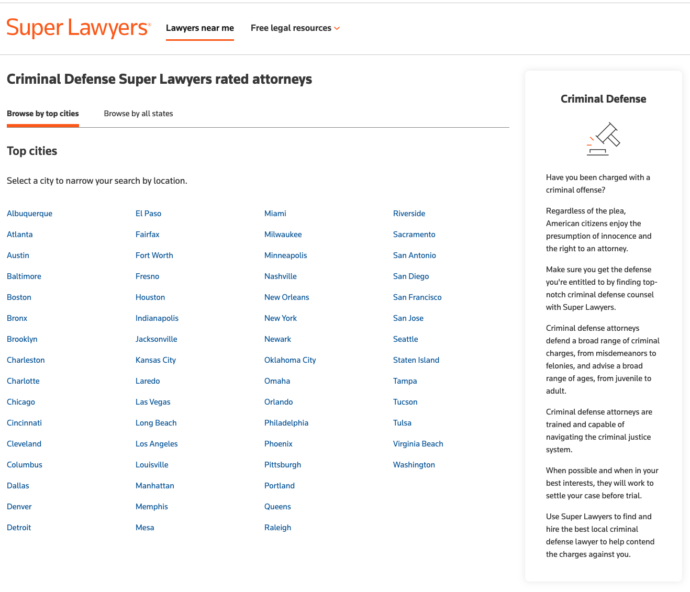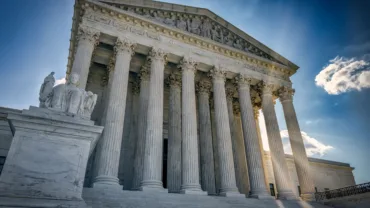Criminal law definition and research resources for attorneys. An overview of the types, sources, elements, and components of criminal law.
Legal terms • criminal law
According to Black’s Law Dictionary, Criminal law is “the body of law defining offenses against the community at large, regulating how suspects are investigated, charged, and tried, and establishing punishments for convicted offenders.”
 | AI news and insights |
Jump to:
| Origin and purpose | Types of criminal behavior | ||
| Sources of criminal law | Elements of criminal law | ||
| Rights of the accused | Components of criminal law | ||
| Types of punishment | Research resources |
Origin and purpose
The earliest known use of the term in English dates back to the 18th century. It’s also termed penal law and deals with wrongdoings that are a threat to all of society, such as rape, murder, and other such heinous offenses.
The penal act might be against one single victim. However, it is a threat to society at large which is why criminal cases are considered offenses against the “state” or the jurisdiction of the prosecution. It comprises the laws and regulations defining criminal offenses and the punishments imposed on those found guilty.
The fundamental goal of criminal law is public safety; it aims to deter destructive or hazardous behaviors. It also establishes the standards of behavior expected of citizens and the punishments for failing to meet those norms. On the other hand, the right to a fair trial, access to legal representation, and a sentence in line with the severity of the crime are all part of these guiding principles of criminal law.
Super Lawyers Select among the top attorneys in the US. |
¹ Source: Black’s Law Dictionary (11th edition)
Types of criminal behavior
The criminal justice system in the United States punishes a wide range of behavior deemed detrimental to public order. These offenses are categorized based on their nature, severity, and statutory definitions.
The following are examples of different classifications of criminal behavior documented in the United States:
Felony |
Anyone convicted of a felony faces a prison sentence of more than one year. This encompasses more serious offenses like murder and manslaughter, and other offenses such as robbery, arson, kidnapping, drug trafficking, and fraud. The penalties for felonies are much harsher than those for misdemeanors.
Misdemeanors |
Misdemeanors are less serious offenses when compared to felonies. Fines, probation, forced community service, and/or up to a year in jail are frequent penalties for such breaches. Misdemeanors are more serious offenses than traffic violations but less serious than felonies.
Minor crimes |
Minor crimes are often known as infractions or ordinance violations. They are typically penalized with monetary penalties. Driving and parking violations, petty drug possession, littering, and causing a public nuisance are all examples of such transgressions.
Drug possession |
Distribution, manufacturing, and sale of prohibited substances are all significant offenses. Drug possession can range from a minor misdemeanor to a huge, organized drug cartel. The kind and quantity of drugs involved determines how severe the punishment for a drug crime will be.
Sexual crimes |
This category includes sexual exploitation, prostitution, and related offenses, such as rape, sexual assault, child molestation, child pornography, and similar acts.
Domestic violence |
The term “domestic violence” refers to any form of abuse done within the context of a domestic or family relationship, whether physical, emotional, or sexual.
Sources of criminal law
Statutory laws |
Statutory law is made up of written laws enacted by federal, state, and local legislative bodies. These statutes or ordinances define specific criminal offenses, their elements, and the penalties associated with them.
Case laws |
Case law, also known as common law, refers to the legal principles and rules developed by courts by interpreting statutes and applying legal precedents. Appellate court decisions, especially those from higher courts, establish legal precedents that subordinate courts are required to observe.
Constitutional laws |
Constitutional law refers to the stipulations and guiding principles detailed in the United States Constitution. It consists of fundamental rights and protections applicable to criminal law, such as the Fourth Amendment’s protection against unreasonable searches and seizures and the Fifth Amendment’s protection against self-incrimination.
Practical Law Criminal law resource types:
|
What are the elements of criminal law?
The prosecution has the burden of proof in a criminal case. They must prove beyond a reasonable doubt that all the elements of the crime were present, which are as follows:
- Actus Reus: The physical act or conduct that makes up the offense. The prosecution must demonstrate that the accused engaged in voluntary and intentional actions or omissions that violated the law.
- Mens Rea: The burden of proof rests with the prosecution. They must show that the accused has the requisite mental state (intent, knowledge, recklessness, or negligence) to commit the crime at issue.
- Concurrence: The necessity of the simultaneous occurrence of an action and its intended result.
- Causation: A defendant’s actions must be shown to have caused the harm or consequences in question.
In United States v. Davis, the Supreme Court clarified the definition of “crime of violence” as used in Title 18, Section 924(c).
The Court held that a “crime of violence” must have as an element the use, attempted use, or threatened use of physical force against another person or property. The Court rejected the “residual clause” approach, which allowed for a broader interpretation of what constitutes a “crime of violence.”
This ruling narrowed the scope of offenses that qualify as “crimes of violence” under Section 924(c). It provided a clearer standard for determining the applicability of enhanced penalties for certain offenses.
Rights of the accused
To ensure that the system is fair and to protect against possible abuses, the US Constitution grants certain rights to people involved in the criminal justice system. Here are some of those rights:
Equal treatment and protection
The Fifth and Fourteenth Amendments guarantee everyone’s right to equal treatment, information about the charges brought against them, and protection from having to testify against themselves in court.
Representation
The Sixth Amendment guarantees all citizens the right to obtain legal representation and provides counsel to those who cannot otherwise afford it.
Trial by impartial jury
The Sixth Amendment guarantees everyone the right to a prompt trial by an impartial jury
Other protections
The Fourth Amendment protects citizens from arbitrary government intrusion and requires probable cause before issuing a search warrant.
Components of criminal law
- Crimes are actions or inactions that break the law and bear criminal punishment.
- Those accused of a crime have the right to utilize legal arguments to defend themselves. Self-defense, mental illness, poverty, pressure, and aimlessness are common defenses.
- Police investigate criminal conduct, collect evidence, and present their findings to prosecutors. The state or government (the prosecutor) then decides whether to file charges.
- In a criminal trial, both parties present evidence, question witnesses, cross-examine them, and make arguments. A judge or jury examines the evidence and decides whether the defendant is guilty or innocent.
- If the defendant is found guilty, the court will impose a sentence that takes the gravity of the offense, mitigating or aggravating circumstances into consideration. Penalties can include time in prison, monetary fines, community service, or a combination.
Types of punishment
Retribution
There must be retribution for wrongdoers. This is the most common and universal expectation.
Because criminals have harmed others unfairly by taking advantage of them, the law penalizes them to “balance the scales.” So the severity of the punishment is proportionate to the seriousness of the crime.
Individualized deterrence focuses on the convicted criminal. The goal is to impose a severe enough punishment to deter future criminal activity.
Societal deterrence is the goal of general deterrence. Others are deterred from breaking the law when those who break it face consequences.
Incarceration
Incarceration is a form of punishment with one simple goal: to keep criminals away from the public.
This is often done through prison terms.. Both the death penalty and exile have accomplished the same goals.
Rehabilitation
The purpose of rehabilitation is to return a former criminal to a productive society. Its primary purpose is to deter the offender from committing further offenses by making them see the error of their ways.
Restoration
In the theory of restoration, the focus is on the victim rather than the offender. The point is to have the state fix whatever damage the offender did to the victim.
For instance, a person who embezzles must pay back the money they stole. Restoring the victim to their pre-injury status is a common goal shared with other branches of criminal justice and is closely related to ideas in civil law.
Research resources
Criminal law has evolved and developed with the changing societal needs as have other laws. Get your free trial of Practical Law to get access to up-to-date information on criminal laws written and maintained by experienced attorneys.
 | Related blog Criminal law software for case management and research |
Related terms:
Below are sample matters related to criminal law. Use the links to browse and preview specific subjects.
Legal updates |
- Criminal Jury Finds Former Uber Security Chief Guilty for Concealing Data Breach
- The relationship between arbitrators and parties under Spanish criminal law
Practice notes |
- Criminal and Civil Liability for Corporations, Officers, and Directors
- Criminal Trial: Discovery of Witness Lists
Toolkits |













